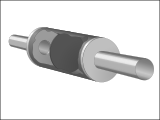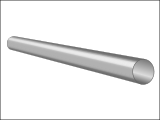Hydraulic analogy
From Wikipedia, the free encyclopedia
The electronic–
hydraulic analogy (derisively referred to as the
drain-pipe theory by
Oliver Heaviside) is the most widely used analogy for "electron fluid" in a metal conductor. Since
electric current is invisible and the processes at play in
electronics are often difficult to demonstrate, the various
electronic components are represented by hydraulic equivalents. Electricity (as well as
heat) was originally understood to be a kind of
fluid, and the names of certain electric quantities (such as
current) are derived from hydraulic equivalents. When taught well, the water analogy is of great use in teaching and in describing basic aspects of electric current. When taught poorly, it misleads more than it teaches. Like all analogies, it demands an intuitive and competent understanding of the baseline
paradigms (electronics and hydraulics).
Basic ideas
There are two basic paradigms:
- Version with pressure induced by gravity. Large tanks of water that are held up high, and the potential energy of the water head is the pressure source. This is reminiscent of electrical diagrams with an up arrow pointing to +V, grounded pins that otherwise are not shown connecting to anything, and so on.
- Completely enclosed version with pumps providing pressure only; no gravity. This is reminiscent of a circuit diagram with a voltage source shown and the wires actually completing a circuit.
Applications: Flow and pressure variables can be calculated in fluid flow network with the use of the hydraulic ohm analogy.
[1][2] The method can be applied to both steady and transient flow situations.
Component equivalents
- Wires
- A relatively wide pipe completely filled with water is equivalent to a piece of wire. When comparing to a piece of wire, the pipe should be thought of as having semi-permanent caps on the ends. Connecting one end of a wire to a circuit is equivalent to forcibly un-capping one end of the pipe and attaching it to another pipe. With few exceptions (such as a high-voltage power source), a wire with only one end attached to a circuit will do nothing; the pipe remains capped on the free end, and thus adds nothing to the circuit.
- Electric potential
- Equivalent to pressure.
- Voltage
- Also called potential difference. A difference in pressure between two points. Usually measured in volts.
- Current
- Equivalent to a hydraulic volume flow rate; that is, the volumetric quantity of flowing water over time. Usually measured in amperes.
- Ideal voltage source
- A dynamic pump. A pressure meter on both sides shows that when this kind of pump is driven at a constant speed, the difference in pressure stays constant.
- Ideal current source
- A positive displacement pump. A current meter (little paddle wheel) shows that when this kind of pump is driven at a constant speed, it maintains a constant speed of the little paddle wheel.

A simple pipe with a constricted region.
- Resistor
- A constriction in the bore of the pipe which requires more pressure to pass the same amount of water. All pipes have some resistance to flow, just like all wires have some resistance to current.

A simple one-way ball-type check valve, in its "open" state.
- Diode
- Equivalent to a one-way check valve with a slightly leaky valve seat. Like a diode, too much reverse bias can damage or destroy the valve assembly.

A flexible-sided rubberized tank with diaphragm.
- Capacitor
- A small rubber tank or thick-walled balloon with one hole at each end and a rubber sheet dividing the tank in two lengthwise.[3] In the case of a polarized capacitor, a leaky valve is contained in each end, one positioned to let water in, the other to let water out. The amount the valve leaks is roughly equivalent to how loosely polarized the capacitor is.
- Inductor
- A heavy paddle wheel placed in the current. The mass of the wheel and the size of the blades restrict the water's ability to rapidly change its rate of flow (current) through the wheel due to the effects of inertia, but, given time, a constant flowing stream will pass mostly unimpeded through the wheel, as it turns at the same speed as the water flow. The mass and surface area of the wheel and its blades is analogous to inductance, and friction between its axle and the axle bearings correspond to the resistance that accompanies any real inductor. An alternative Inductor model is simply a long pipe; this device is used in real life as an essential component of a hydraulic ram. The inertia of the water flowing through the pipe produces the inductance effect. The drag imposed by the walls of the pipe is somewhat analogous to parasitic resistance.

A pressure-actuated valve combined with a one-way check valve.
- Transistor
- A valve in which a diaphragm controlled by a low-current signal (either constant current — BJT, or constant pressure — FET) moves a plunger which affects the current through another section of pipe.
- CMOS
- A combination of two MOSFET transistors. As the input pressure changes, the pistons allow the output to connect to either zero or positive pressure.
- Memristor
- A needle valve operated by a flow meter. As water flows through in the forward direction, the needle valve restricts flow more; as water flows the other direction, the needle valve opens further providing less resistance.
Like a one-way check valve, a diode blocks current that flows the wrong way. Current that flows the right way goes through almost unchanged. | A simple A/C circuit consisting of an oscillating pump, a "diode" valve, and a "capacitor" tank. Any kind of motor could be used here to drive the pump, as long as it oscillates. |
Principle equivalents
- EM wave speed (velocity of propagation)
- Speed of sound in water. When a light switch is flipped, the electric wave travels very quickly through the wires.
- Charge flow speed
- Particle speed of water. The moving charges themselves move rather slowly.
- DC
- Constant flow of water in a circuit of pipe
- Low frequency AC
- Water oscillating back and forth in a pipe
- Higher-frequency AC and transmission lines
- Sound being transmitted through the water pipes
- Inductive spark
- Used in induction coils, similar to water hammer, caused by the inertia of water
See also
Bond graph.
Equation examples
Some examples of equivalent electrical and hydraulic equations:
If the differential equations have the same form , the response will be similar .
Limits to the analogy
If taken too far, the water analogy can create misconceptions. For it to be useful, we must remain aware of the regions where electricity and water behave very differently.
- Fields
- Electrons can push or pull other distant electrons via their fields, while water molecules experience forces only from direct contact with other molecules. For this reason, waves in water travel at the speed of sound, but waves in a sea of charge will travel much faster as the forces from one electron are applied to many distant electrons and not to only the neighbors in direct contact. In a hydraulic transmission line, the energy flows as mechanical waves through the water, but in an electric transmission line the energy flows as fields in the space surrounding the wires, and does not flow inside the metal. Also, an accelerating electron will drag its neighbors along while attracting them, both because of magnetic forces.
- Charge
- Unlike water, electric charge can be positive or negative. The charge carriers in electric currents are usually electrons, but sometimes they are positively charged particles.
- Leaking pipes
- If a hole is made in a hydraulic system, the water can leak out. But the movable charges present within electrical conductors are always attracted to unmoving opposite charges in the material. The "electric fluid" can be forcibly removed from metals, but enormous voltages arise if even a tiny amount is removed. For this reason, the surfaces of conductors act as if they always have a high energy-barrier preventing leaks. Also for this reason, continuing electric currents require closed loops rather than hydraulics' open source/sink resembling spigots and buckets.
- Fluid Velocity
- As with water hoses, the carrier drift velocity in conductors is directly proportional to current. However, charges' velocity within a conductor is typically less than centimeters per minute, and the "electrical friction" is extremely high. If charges ever flowed as fast as water can flow in pipes, the amperage would be immense, and the conductors would become incandescently hot and perhaps vaporize. To model the resistance and the charge-velocity of metals, perhaps a very narrow straw would be a better analogy than a typically sized pipe.
- Quantum Mechanics
- Conductors and insulators contain charges at more than one quantized level of atomic orbit energy, while the water in one region of a pipe can only have a single value of pressure. For this reason there is no hydraulic explanation for such things as a battery's charge pumping ability, a diode's voltage drop, solar cell functions, Peltier effect, etc, however equivalent devices can be designed which exhibit similar responses, although some of the mechanisms would only serve to regulate the flow curves rather than to contribute to the component's primary function.
Notes
- ^ A. Akers, M. Gassman, & R. Smith, Hydraulic Power System Analysis. Taylor & Francis, New York, 2006, Chapter 13, ISBN 0-8247-9956-9.
- ^ A. Esposito, "A Simplified Method for Analyzing Circuits by Analogy". Machine Design, October 1969, pp. 173-177.
- ^ http://amasci.com/emotor/cap1.html
See also
External links
Good analogy
Acceptable analogy
 [J/s]
[J/s] [W/m2]
[W/m2]









1 comment:
Meters help determine if a leak is occurring. They can also measure compressor performance. That is a great benefit as your operators and maintenance staff will note measurement warnings of system failures and can then repair or adjust compressors that have decided to take a vacation from proper operations.
Hydraulic Flowmeter
Post a Comment